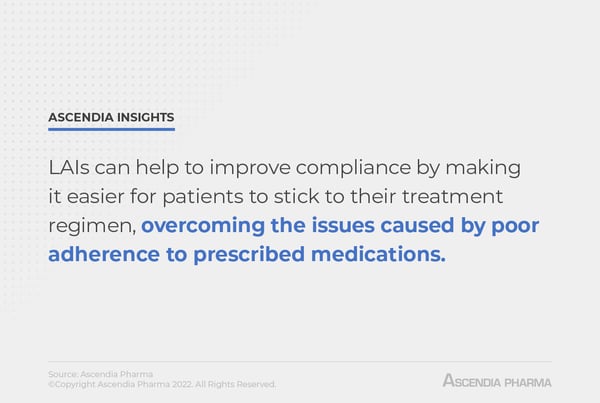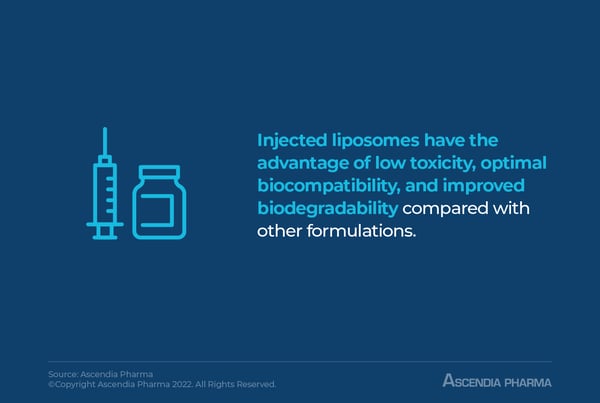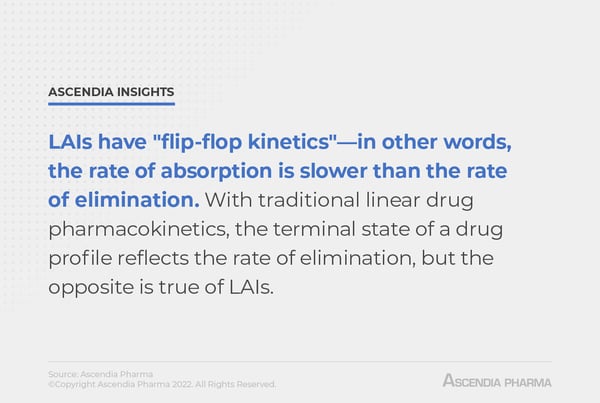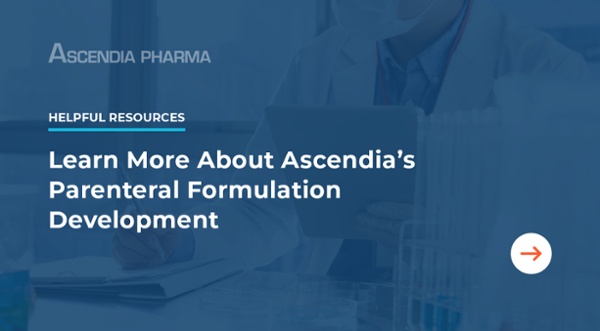Long-Acting Injectables (LAIs): Benefits & Drug Development
Long-acting injections represent a sea change in the way medications are administered, allowing patients to forgo once-or-twice-daily prescription medications using a different drug delivery method and instead go weeks between dosages.
As the demand for long-acting injectables (LAIs) grows, so does the need for new and innovative drug delivery systems. LAIs are becoming a significant part of the treatment landscape for many chronic conditions, but the same qualities that make these drugs so desirable also make formulation a challenge for scientists at pharmaceutical and biopharma companies..
Uses for Long-Acting Injectables
Long-acting injectables, or parenteral sustained-release drug delivery systems, are injected into the body, usually either via subcutaneous or intramuscular injection, and then slowly released over time. (Intravenous, intraocular, implant, and intra-articular routes are also options, but much less common). Controlled release dosages can last anywhere from 2 to 12 weeks, depending on the drug in question.

LAIs have traditionally been used to treat psychosis in patients with schizophrenia, but they are also used as a mood stabilizer for bipolar disorder. Other uses for long-acting injections include:
- Chronic pain
- Hormonal contraception
- Bipolar disorder
- Bone health
- Cancer
- Infectious diseases (HIV, Malaria, TB, Hepatitis C)
- Periodontal disease
- Migraines
- Diabetes
That said, virtually any chronic health condition has the potential to be better managed with LAIs. When there is a benefit to patients in receiving a long-acting injection, and these benefits outweigh any disadvantages, there is reason to pursue a long-acting injectable treatment.
Benefits of Long-Acting Injections
Long-acting injectables offer a number of potential benefits for patients and physicians. For patients, LAIs can provide a more consistent level of medication in the body, which can lead to fewer side effects and improved symptom control. Some patients may find that LAIs are easier to take than other more traditional forms of medication, such as pills or liquids; because LAIs are typically injected only once or twice a month. They can be more convenient than taking multiple doses of medication each day.
For patients with schizophrenia, long-acting injections represent a significant improvement in quality of life. LAIs help improve patient compliance, which is often a problem with chronic mental health conditions like schizophrenia. When patients are more likely to comply with their treatment, it reduces the number of relapses, allowing patients and their families to live their lives with less disruption.
Another potential benefit of LAIs is that they may be less likely to cause weight gain than other dosage forms. A common side effect of many psychiatric medications, weight gain can lead to serious health problems, such as diabetes. Because LAIs are slowly released into the body, they are less likely to cause the unwanted weight gain that can occur with other drugs.

When LAIs are used to treat chronic pain or other disorders local to specific areas of the body, they allow for advanced targeting. Medication can be injected precisely where needed and the long-acting formulation ensures that a high drug concentration can be maintained in the area without causing systemic exposure and subsequent side effects.
For physicians, LAIs can be a valuable tool in treating chronic conditions. LAIs can help to improve compliance by making it easier for patients to maintain their treatment regimen, overcoming the issues caused by poor adherence to prescribed medications. Because LAIs provide a more consistent level of medication in the body, they can be more effective in managing symptoms and preventing relapses.
In light of the ongoing opioid epidemic, LAIs also hold promise in reducing drug abuse. Injectable formulations must be administered by a healthcare professional, so there is no risk of patients taking a higher dose than prescribed or sharing their medication with others.
Finally, long-acting injections have the potential to reduce healthcare costs. Because LAIs are injected only once or twice a month, they require fewer office visits than other dosage forms. In the case of schizophrenia, the reduced risk of relapse means fewer hospitalizations, which also reduces the overall cost of medical care for a patient.
Long-Acting Injection Dosage Forms
Within the category of long-acting injections are a number of different dosage forms, each with its own advantages, disadvantages, and best uses. As Ascendia’s Founder and CEO Jim Huang, PhD outlines in his Formulation Form column for Drug Development & Delivery, the most common long-acting injection dosage forms include:
Drug Crystal Suspensions
Drug crystal suspensions consist of nano- or micro-crystals of a hydrophobic drug with a small amount of surfactant or excipient. These drugs are formulated using micronization and nanomilling; solubility increases as the particle size decreases. Transferring these formulations to a long-chain fatty acid can increase half-life, which causes drugs to dissolve slowly at the injection site following an intramuscular injection.
Invega® Sustenna®, used for schizophrenia and schizoaffective disorder, is an example of an LAI with a drug crystal suspension formulation.

Liposomes
Liposomes and other lipid-based nanoparticles (LNPs) suspend phospholipids and cholesterol in an aqueous medium. Liposomes can be used with both hydrophilic and hydrophobic drugs, and can be administered intravenously, intramuscularly, or subcutaneously to target specific areas of the body.
Two commonly used liposome technologies are Stealth Liposome Technology and DepoFoam Technology. The former uses a polymer to improve circulation of a dosage once it’s administered, while the latter sustains the release of a drug for up to 30 days by encapsulating it in multivesicular liposomes.
Injected liposomes have the advantage of low toxicity, optimal biocompatibility, and improved biodegradability compared with other formulations.
Polymeric Microspheres
Polymeric microspheres are microscopic spherical particles made from biodegradable polymers. In addition to allowing for sustained release, this formulation offers improved stability in storage and after administration. In this formulation, a drug is entrapped in a polymer matrix.
Polymer nano-medicines may be polymer-drug conjugates that increase the half-life and bioavailability of a drug, or provide a degradable polymer architecture that enables controlled-release.
Polymeric in Situ Gel Systems
Polymeric in situ gel systems are semisolid, jelly-like formulations that solidify at the site of injection. In situ gels can be used to deliver both hydrophobic and hydrophilic drugs, and they are typically injected subcutaneously. Injectable gels offer an alternative to traditional implantable drug delivery devices, as they can be easily injected using a needle and syringe.
Oil-based Injections
Oil-based injections are suspensions or solutions of lipophilic drugs in an oil carrier. By controlling the viscosity of the carrier, the absorption process can be prolonged.
Oil-based injectables are typically administered intramuscularly, but they have the potential for discomfort, and they may cause patients to experience temporary local irritation and inflammation at the injection site.
Pellet Implants
Pellet implants are tiny, cylindrical pellets that contain a drug. They are typically made from biodegradable polymers. Pellet implants are injected subcutaneously and can offer a sustained release of the drug for several months or even years. That said, pellet implants require a surgical procedure for insertion, which may present an obstacle for some patients.

Long-Acting Injectable Drug Development
Because of the benefits of long-acting injectables, they are becoming more prominent in the drug development pipeline. Unfortunately, the development of LAIs requires a great deal of skill and knowledge, as well as advanced nano-technologies because these drugs have unique pharmacokinetic characteristics.
LAIs have "flip-flop kinetics"—in other words, the rate of absorption is slower than the rate of elimination. With traditional linear drug pharmacokinetics, the terminal state of a drug profile reflects the rate of elimination, but the opposite is true of LAIs.
The crux of LAI design is understanding the drug therapeutic window, or the minimum effective concentration and minimum toxic concentration. Because of the nature of these drugs, a misstep here can be catastrophic; it’s critical to understand the absorption characteristics of the active drug at the injection site and its stability throughout the dosing interval. Absorption rate may also be impacted based on blood flow, enzymes, pH, and macrophage uptake, among other factors.
Model-informed drug development holds promise for the development of LAIs, and generics in particular, as it can help to optimize dosing and reduce the risk of adverse events. This approach uses mathematical modeling to simulate the release of a drug from an injection site and predict how it will be absorbed by the body over time.
Once an LAI has been developed and is ready to be manufactured for clinical trials, it has the same challenges as other parenteral drugs—namely, it must be manufactured in an aseptic environment to ensure sterility and securely packaged to prevent impurities. Ascendia Pharmaceuticals offers fast, flexible, and small-batch size services for conducting first-in-man studies efficiently to stay on schedule and within budget.
Leading the Way in Long-Acting Injectable Development
Our team at Ascendia Pharma specializes in parenteral formulation development and has been at the forefront in developing long-acting injectable formulations. Our nanotechnologies - particularly NanoSol® and EmolSol® - have been used to solve the most difficult LAI formulation challenges.
Those nano-technologies, coupled with our experienced team of scientists, allows us to develop advanced formulations that allow drugs used in other delivery methods to become injectables. Such capabilities create new revenue streams and increased drug return on investment (ROI).
As a CDMO, we assist our partners in overcoming some of the most common challenges in parenteral drug development, including instability, poor solubility, and low bioavailability. Once development is complete, we’re ready to hit the ground running and start manufacturing your sterile injectable clinical trial materials.
With our proven track record and BEST (Brilliant technology, Excellent service, Superior quality, and Trust) philosophy, we’re well-equipped to develop innovative LAI formulations. Contact us today to learn more about partnering with Ascendia.


